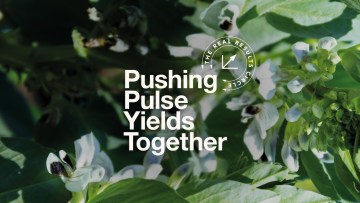May Pulse Check
28 May 2021

Next in our series of Pulse Checks is Roger Seed, a qualified agronomist, farm business adviser and third generation farmer.
Roger has been working alongside his father, Jonathan, since the family moved to a farm just outside Oxford in 1980. The 145ha home farm is primarily very heavy Denchworth type clay and they contract farm a further 155ha, which mostly sits on lighter soils.
Roger and his father specialise in growing seed crops. The venture started with peas in the late 1980s. Today, with the exception of OSR, just about everything they grow is for seed production.
They’ve historically followed a six-year rotation, with two cereals followed by either rape or peas, but the very wet harvest of 2012 forced them to reconsider their cropping and reintroduce spring barley – a crop they last grew in the 1980s.
They are now considering another change to their rotation. Having grown peas for nearly 40 years, they are trialling spring beans. Read on to find out why.
Why do you favour seed production?
We are a modest size farm so we’re trying to derive as much value as possible from the area. We enjoy the challenge and it’s an effective driver to keep the farms clean and in good heart. It’s also down to the excellent long term relationship we have with key merchants, in particular ADM Agriculture; it’s a genuine partnership and we enjoy working with their seed people at Long Sutton.
What impact does producing a seed crop have on your crop management?
In the field, rotation has to be considered very carefully The husbandary of previous crops, as well as the seed crop itself, has to be spot on to ensure it passes the necessary production standards and inspections.
A timely harvest is critical. We’re chasing germination in particular so it’s imperative crops are cut in good time and not left in the field too long. As a consequence, we are slightly over-combined for the acreage, running a Claas Lexion 570TT. Machinery hygiene is really important at harvest too. Equipment has to be thoroughly cleaned down between harvesting the different varieties. Drying a seed crop can also take longer as we have to use lower temperatures.
But we get a premium which, if we’ve done our job right, is worth more than the extra cost of producing these crops.
We also get early movement. The winter crops are usually gone by mid October and the spring crops tend to go at Christmas or soon after. It suits us.
Why are you thinking of moving from peas to beans?
In the past we have grown anywhere from 20 to 30ha of peas. For years it was a high quality, marrowfat variety, Kabuki. We’ve also dabbled with large blues such as Daytona .
Even though we are growing peas only 1 year in 6, the weather conditions have definitely changed in the past decade, and on our heavy land this has undoubtedly made successful pea production more challenging. Very dry springs hinder germination and peas do not enjoy wet feet either, so the last few seasons have posed real problems for setting up a good crop. And the loss of diquat has brought about a different set of challenges at harvest time – seed production prohibits the use of glyphosate, so we no longer have a desiccant option for seed pea production, and on our heavy land we struggle to get even maturity without one.
We think beans maybe a little more resilient to the climatic conditions we’re facing – they are traditionally more of a heavy land crop. We’ve got some peas in the ground this year but if the spring beans work for us, going forward we’ll be increasing the acreage on the heavy land.
We may still grow peas, but on our lighter, contracted land. Here, where OSR has failed, we’ve experimented with Kabuki and they did really well, yielding over 4t/ha and with excellent germination and colour retention. So if rape continues to struggle we may increase peas on the lighter land.
How do you get the most out of your peas?
Establishment
From our experience, the key is to get conditions right in the autumn so you can retain moisture and get the crop established in spring without damaging the soil.
On our heavy land, we’ve found working the ground in the autumn, but leaving enough for the weather to work on, is the most successful approach. We have dabbled with some green cover but on our heavy clays this appears counter-productive, with soils taking so much longer to dry out in the spring, pushing drilling dates back.
After that, peas are the same as any other crop, albeit more sensitive; you just need to keep on top of weeds, pests and disease.
Crop Protection
Grass weeds, charlock and cleavers are the main weed focus on the home farm. In the spring we also get flushes of black bindweed, redshank, knotgrass, and mayweed.
On the contracted farms we see weeds more typical of lighter land; poppies, speedwells and pansies, for example.
For weed control, there are few post-emergence options so we tend to major on crop cleanliness in the preceding crops, a timely application of glyphosate pre-drilling and then focus on pre-ems - typically 4l/ha Nirvana® (pendimethalin and imazamox) and 0.25l/ha of clomazone. We’ve not used a post-em for a while, as the combination of glyphosate and pre-em has generally done a good job.
The disease pressure in peas can be challenging depending on the season. 0.5kg of Signum® (boscalid and pyraclostrobin) is doing the job.
We were using products like Alto Elite® (chlorothalonil and cyproconazole), but the loss of this chemistry has led to us switching to Signum®. It is a step up with the SDHI chemistry, and appears to be giving us more control and persistance. I’ve seen the greening effect from the same chemistry in cereals, and am sure that pyraclostrobin helps crops cope better with drought stress. While it’s not been quantified in pulses, I’m conscious that there’s that advantage with this sort of chemistry.
When it comes to pests, pea and bean weevil are nearly always present. Later in the season we monitor for aphids and trap for pea moths. If thresholds are reached we’ll apply an appropriate treatment.
What about your spring beans?
This year we’re growing around 25ha. We were limited by availability of seed so it’s not a large acreage. The crop of LG Viper was drilled on 25th March.
Establishment
We’re testing two establishment approaches for our spring beans. Most of the land has had a pass with the Simba solo in the autumn, but a small area was winter ploughed on the frost in late January. There were two reasons for trying winter ploughing. We wanted to see which is more effective for spring beans and the weather also closed in on us very quickly in October, preventing any further autumn cultivation.
In the spring, immediately pre-drilling, the land got a light harrow and then we went in with the Horsh Sprinter on 1” Dutch openers, drilled 5 to 7cm deep with 25cm row widths.
The most important elements are ensuring good drainage, seed-to-soil contact and moisture retention. Depth is also important from the pre-em perspective. Regardless of what you’re drilling, you can’t be smearing soils in spring. You have to work with the soil so you’ve a reasonable tilth around the seed and no compaction. Sometimes we will adjust our depth to avoid damaging the soil around the seed.
Crop Protection
To create a better surface for the pre-ems, Nirvana® and clomazone, we rolled.
With the exceptionally wet May and forecasted increase in temperatures, disease is very much on our radar. Our fungicide programme will be 0.5kg Signum® at the onset of flowering. We’re hoping to do just one fungicide but if this weather keeps up, we might need to rethink that!
How are you beans looking now?
They are looking well, despite the wet. We’ve got a really good even stand but they need some warmth and drier feet.
Next action is to get a nutrient feed on them. With all the weather we’ve had, they are undoubtedly a bit stressed. The tissue analysis is going off tomorrow and I’m planning applications of molybdenum, manganese and zinc. Molybdenum will help root nodulation. I’ll also be speaking with some local beekeepers to see if they would like to put some bees out to help with pollination.
What yield are you aiming for?
The budget is 3.5t/ha and aspiration is 5t/ha. In my advisory work I‘ve seen spring beans do as little as 2t/ha and as much as 6t/ha plus. Weather plays a huge part in final yield potential of the crop and their performance does seem to be a bit more variable than some other crop options. But they are an excellent break crop and a great entry for wheat. I would be very happy with 4.5t/ha but we do need it to dry up and warm up quickly to have a chance of achieving that. We’ve had 115mm of rain since 1st May here and if we get more in the next fews weeks, there’s no doubt that they will start to suffer.
Use plant protection products safely. Always read the label and product information before use. For further product information including warning phrases and symbols refer to north_east www.agricentre.basf.co.uk . For further information, please do not hesitate to contact your local BASF Agronomy Manager or the BASF Technical Services Hotline: 0845 602 2553. Signum® contains boscalid and pyraclostrobin. Nirvana® contains pendimethalin and imazamox. Alto Elite® contains chlorothalonil and cyproconazole. Signum® and Nirvana® are registered Trademarks of BASF. All other brand names used on this publication are Trademarks of other manufacturers in which proprietary rights may exist. © BASF 2021. All rights reserved.


